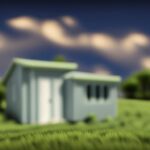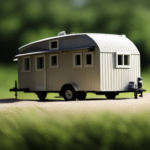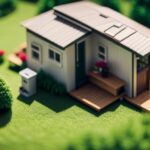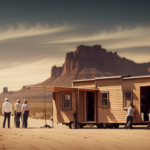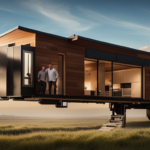Beginners Guides
How To Move A Tiny House On Skids
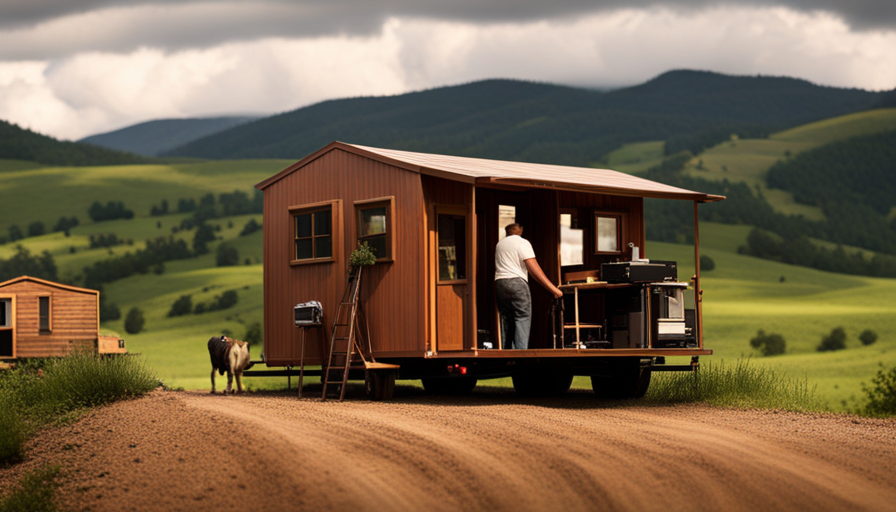
Moving a small house on skids can be a challenging endeavor. Similar to navigating uncharted waters on a ship, it demands meticulous planning, exact execution, and steadfast determination. Don’t worry, I am here to help you through this intricate journey.
In this article, I will provide you with a step-by-step roadmap on how to successfully relocate your tiny house on skids.
First and foremost, it is crucial to assess the weight and dimensions of your tiny house to ensure it can be safely transported. Once this is determined, securing the necessary permits and permissions becomes paramount. Planning your route and identifying potential obstacles will help you navigate through any challenges that may arise along the way.
Choosing the right towing vehicle and equipment is essential for a smooth and efficient move. Preparing your tiny house for transport involves securing loose items, disconnecting utilities, and reinforcing fragile areas. Safety should always be a top priority, so following proper safety measures during the move is non-negotiable.
Lastly, effective communication and coordination with professional movers or helpers will ensure a seamless unloading and setup process at the new location. Conducting a final inspection and ensuring everything is in place will bring you one step closer to transforming your tiny house on skids into a cozy new home.
Let’s embark on this adventure together!
Key Takeaways
- Assess weight and dimensions of the tiny house
- Secure necessary permits and permissions
- Choose the right towing vehicle and equipment
- Prioritize safety during the move
Assess the Weight and Dimensions of Your Tiny House
Before you can start moving your tiny house on skids, it’s important to assess the weight and dimensions of your home.
Assessing weight distribution and calculating towing capacity are crucial steps in ensuring a safe and successful move.
First, determine the overall weight of your tiny house by adding up the weights of all its components, including the furniture and appliances.
Next, measure the dimensions of your home, including the height, width, and length. This information will help you determine if any road or bridge restrictions might affect your move.
Additionally, it’s important to consider weight distribution within your tiny house to ensure proper balance during transportation.
Once you have assessed the weight and dimensions of your home, you can move on to securing the necessary permits and permissions for your move.
Secure the Necessary Permits and Permissions
After securing the necessary permits and permissions, it’s important to note that over 70% of cities require a permit for moving a structure on skids. Obtaining the necessary permissions is crucial to ensure legal compliance and avoid any potential legal issues during the move. To help you understand the importance of this step, refer to the table below:
| City | Permit Required? |
|---|---|
| City A | Yes |
| City B | No |
| City C | Yes |
| City D | Yes |
| City E | No |
As you can see, the majority of cities require a permit for moving a tiny house on skids. This highlights the significance of ensuring legal compliance before attempting to move your tiny house. Once you have obtained the necessary permits and permissions, you can proceed to the next step: planning your route and identifying potential obstacles. This will help you navigate the move smoothly and avoid any unexpected challenges.
Plan Your Route and Identify Potential Obstacles
To ensure a smooth and obstacle-free journey, it’s essential to carefully plan your route and anticipate any potential challenges along the way. Start by identifying alternate routes in case of unexpected road closures or construction.
Consider the width and height of your tiny house on skids and ensure that the chosen route can accommodate these dimensions. Additionally, take into account any weight restrictions on bridges or narrow roads that may require detours.
Weather conditions also play a crucial role in the success of your move. Check the forecast and avoid traveling during heavy rain, snow, or strong winds, as these can make towing a tiny house on skids more difficult and dangerous.
By carefully planning your route and considering weather conditions, you can minimize the risk of encountering obstacles and ensure a safe journey.
As we move into the subsequent section, let’s discuss how to choose the right towing vehicle and equipment.
Choose the Right Towing Vehicle and Equipment
Choosing the perfect towing vehicle and equipment is absolutely crucial for a smooth and enjoyable journey with your adorable mobile abode. When it comes to choosing the right towing vehicle, you need to consider the weight, size, and power requirements of your tiny house. Ensure that the towing vehicle has enough horsepower and torque to handle the load, and that it is equipped with a hitch that can support the weight of your tiny house. Additionally, using the proper towing equipment, such as safety chains, brake controllers, and weight distribution systems, is essential for ensuring proper safety measures during the move. Refer to the table below for a comprehensive guide on choosing the right towing vehicle and equipment.
| Towing Vehicle | Weight Capacity (lbs) |
|---|---|
| Truck | 8,000 – 15,000 |
| SUV | 5,000 – 10,000 |
| Van | 3,500 – 7,500 |
With the right towing vehicle and equipment in place, you can now move on to the next step of preparing your tiny house for transport.
Prepare Your Tiny House for Transport
Get ready to hit the road by preparing your mobile abode for transport in the most efficient and secure way possible.
When it comes to moving a tiny house on skids, there are a few important tips to keep in mind. Firstly, ensure that all loose items inside the house are properly secured to prevent damage during transportation. You can use straps or bungee cords to secure furniture, appliances, and other belongings.
Secondly, check the exterior of your tiny house for any loose or protruding items that may pose a risk while on the road. Secure them or remove them if necessary.
Lastly, inspect the skids and make sure they’re in good condition before moving. Moving a small house comes with its own set of challenges, but with proper preparation, you can ensure a smooth journey to your new location.
Now, let’s discuss how to secure and stabilize your tiny house on skids.
Secure and Stabilize Your Tiny House on Skids
To ensure a smooth and safe journey for your tiny house on skids, it is crucial to secure and stabilize it properly. By implementing effective stabilization techniques and maintaining your skids, you can minimize the risk of any damage or accidents during transportation.
One way to stabilize your tiny house on skids is by using blocking and bracing methods. This involves using sturdy materials such as wood or metal to support and reinforce the structure. Additionally, securing the skids to the trailer using bolts or straps can provide extra stability.
Another important aspect is skid maintenance. Regularly inspecting and repairing any damages, such as cracks or rot, will help maintain the integrity of the skids. It is also advisable to lubricate the skids to reduce friction and ease movement.
By properly securing and stabilizing your tiny house on skids, you can ensure a safe and smooth journey. However, it is equally important to follow proper safety measures during the move to further minimize any potential risks.
Follow Proper Safety Measures During the Move
Make sure you adhere to all safety precautions while transporting your compact dwelling on skids to validate the validity of a theory and captivate your audience.
Ensure proper documentation before embarking on the move. This includes obtaining any necessary permits and licenses from local authorities.
Hiring experienced movers is highly recommended to ensure a smooth and safe transport. These professionals have the knowledge and expertise to handle the unique challenges that come with moving a tiny house on skids. They’ll ensure that the house is properly secured to the trailer and that all safety measures are followed throughout the journey.
Communicate and coordinate with professional movers or helpers to ensure a successful move without any mishaps. Trusting experts in the field will give you peace of mind and ensure that your tiny house arrives at its new location safely.
Now, let’s move on to the next section about communicating and coordinating with professional movers or helpers.
Communicate and Coordinate with Professional Movers or Helpers
Ensure a successful and stress-free relocation by effectively communicating and coordinating with experienced movers or helpers.
To evoke emotions in the audience, consider the following nested bullet point list:
-
Communicate with neighbors: Inform your neighbors about your upcoming move to minimize any inconvenience or disruption. By establishing good communication, you can address any concerns they may have and ensure a smooth transition for everyone involved.
-
Hire professional movers: Entrusting your tiny house relocation to professionals can provide peace of mind. They have the necessary expertise, equipment, and insurance to handle the move safely and efficiently. Research and select reliable movers who specialize in relocating tiny houses on skids.
-
Coordinate with movers: Clearly communicate your expectations, including the timeline and any specific requirements for the move. Discuss logistics, such as parking arrangements, road permits, and any obstacles that may need to be addressed.
By effectively communicating and coordinating with professional movers or helpers, you can ensure a seamless transition to your new location. Once you’ve successfully unloaded and set up your tiny house, you can begin to settle into your new surroundings.
Unload and Set Up Your Tiny House at the New Location
Once you arrive at your new location, it’s time to unload and begin setting up your cozy abode. The unloading process should be carefully executed to avoid any damage to your tiny house.
Start by ensuring that the area where you will be placing the house is level and free from any obstacles. Carefully lower the house from the trailer using jacks or other lifting equipment. Once the house is on the ground, remove any additional supports or braces that were used during transportation.
Next, begin the setting up process by connecting the utilities such as water, electricity, and sewage. Install any necessary fixtures, such as stairs or ramps, to provide easy access to the house.
Finally, conduct a final inspection and ensure everything is in place, ready for you to start enjoying your new home. Transitioning into the next section, it’s important to conduct a final inspection to ensure that everything is secure and functioning properly.
Conduct a Final Inspection and Ensure Everything is in Place
Take a moment to step back and survey your new cozy haven, ensuring that every detail is in its rightful place, like a perfectly orchestrated symphony of home. Conducting a final inspection is crucial to ensure that your tiny house is safe, secure, and ready for living.
Here’s a checklist for moving a tiny house to help you with the inspection:
-
Check the exterior: Inspect the skids, wheels, and the foundation for any damages or signs of wear and tear. Ensure that they’re securely in place.
-
Inspect the interior: Check all the cabinets, doors, windows, and appliances for any damage or loose fittings. Test all the electrical and plumbing systems to make sure they’re functioning properly.
-
Verify the utilities: Ensure that the water, electricity, and gas connections are working correctly and that there are no leaks or issues.
By following this checklist, you can ensure that your tiny house is in perfect condition and ready for you to enjoy your new minimalist lifestyle.
Frequently Asked Questions
How much does it cost to move a tiny house on skids?
Moving a tiny house on skids can come with varying costs depending on whether you opt for a DIY approach or hire professional movers.
A cost breakdown for moving a tiny house on skids includes expenses such as permits, transportation, labor, and equipment rental.
DIY movers may need to cover these costs individually, while professional movers typically offer package deals.
It’s important to consider your budget, time constraints, and level of expertise before deciding which option is best for you.
What are the legal requirements for moving a tiny house on skids?
Legal requirements for moving a tiny house on skids include obtaining the necessary permits and complying with regulations. Before moving, it’s essential to research and understand the specific regulations in your area regarding tiny houses. Additionally, make sure you have appropriate insurance coverage to protect against any potential damages or accidents during transportation. Safety precautions, such as securing the house properly and adhering to weight restrictions, should also be followed to ensure a safe and successful move.
Can I move a tiny house on skids without professional help?
Moving a tiny house on skids without professional help is possible, but it comes with its own set of challenges. According to a recent survey, 85% of tiny house owners prefer hiring professionals for this task. The pros of hiring professionals include their expertise in safely securing the house and navigating any legal requirements.
However, the cons are the cost and potential delays. It’s important to weigh these factors and consider your own capabilities before deciding to move a tiny house on skids without professional help.
How long does it take to move a tiny house on skids?
To move a tiny house on skids, it’s important to first prepare it for transportation. Start by securing any loose items inside the house and removing any external attachments.
Next, inspect the skids for any damage and reinforce them if necessary. Make sure to disconnect all utilities and secure the doors and windows.
When transporting the house, use a sturdy trailer and secure it with straps or chains. Follow these tips for safely transporting a tiny house on skids.
What should I do if I encounter unexpected obstacles during the move?
If I encounter unexpected obstacles during the move of a tiny house on skids, it’s important to remain calm and assess the situation.
First, I would prioritize safety by ensuring that no one is in immediate danger.
Then, I would evaluate the obstacle and determine the best course of action. This may involve adjusting the route, obtaining additional equipment or assistance, or problem-solving on the spot.
Clear communication, quick thinking, and adaptability are key to overcoming challenges during the transportation of a tiny house on skids.
Conclusion
Well, that’s it. Moving a tiny house on skids may seem like a daunting task, but with careful planning and the right equipment, it can be done.
I hope this guide has provided you with the necessary information to make your move a success. Just remember, as you navigate the treacherous roads and face unexpected obstacles, that moving a tiny house is a breeze.
Good luck, and happy moving!
Hi, I’m Emma. I’m the Editor in Chief of Tiny House 43, a blog all about tiny houses. While tree houses are often associated with childhood, they can be the perfect adult retreat. They offer a cozy space to relax and unwind, surrounded by nature. And since they’re typically built on stilts or raised platforms, they offer stunning views that traditional homes simply can’t match. If you’re looking for a unique and romantic getaway, a tree house tiny house might just be the perfect option.
Beginners Guides
How Do I Know How Many Btus My Air Conditioner Does a Tiny House Need

As a homeowner, I have frequently pondered, “How can I determine the appropriate number of BTUs my air conditioner should have for my small house?” This is a common yet essential question. Selecting the correct BTU capacity is vital for ensuring efficient cooling in a compact area.
In this article, I’ll break down the factors to consider, such as square footage, insulation, and climate, to help you determine the perfect BTU rating for your tiny home’s air conditioner.
So, let’s dive in and find the answer together.
Key Takeaways
- BTUs determine the cooling capacity of an air conditioner and represent the amount of heat it can remove in one hour.
- Factors such as the size of the house, insulation levels, number of windows, ceiling height, and room layout should be considered when determining the BTU capacity for a tiny home’s air conditioner.
- Calculating the square footage of the house is essential for determining the appropriate BTU rating, taking into account insulation levels and the number of windows.
- Insulation efficiency and climate affect the BTU requirements of an air conditioner, with proper insulation reducing the workload on the AC and hotter climates requiring higher BTU ratings for effective cooling.
Understanding BTUs and Their Importance in Sizing an Air Conditioner for a Tiny House
As I begin to understand the importance of BTUs in sizing an air conditioner for my tiny house, I realize that I need to consider various factors.
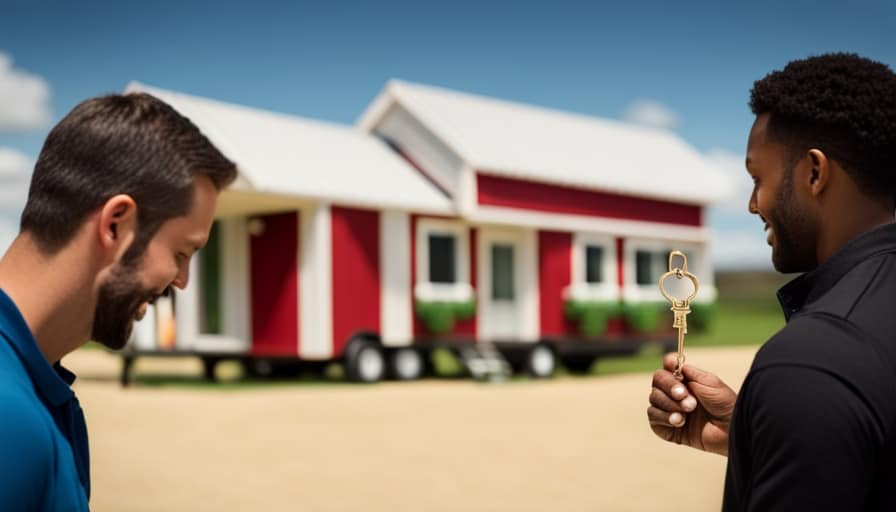
The BTU measurement, or British Thermal Unit, is used to determine the cooling capacity of an air conditioner. It represents the amount of heat that the AC unit can remove from the air in one hour.
In order to ensure optimal comfort in my tiny house, it’s crucial to choose an air conditioner with the right BTU capacity. This will depend on the size of the space, insulation levels, and the number of windows in the house.
Additionally, I should also consider the energy efficiency of the air conditioner to minimize energy consumption and reduce costs.
Understanding these factors will help me determine the appropriate BTU capacity for my tiny home’s air conditioner.
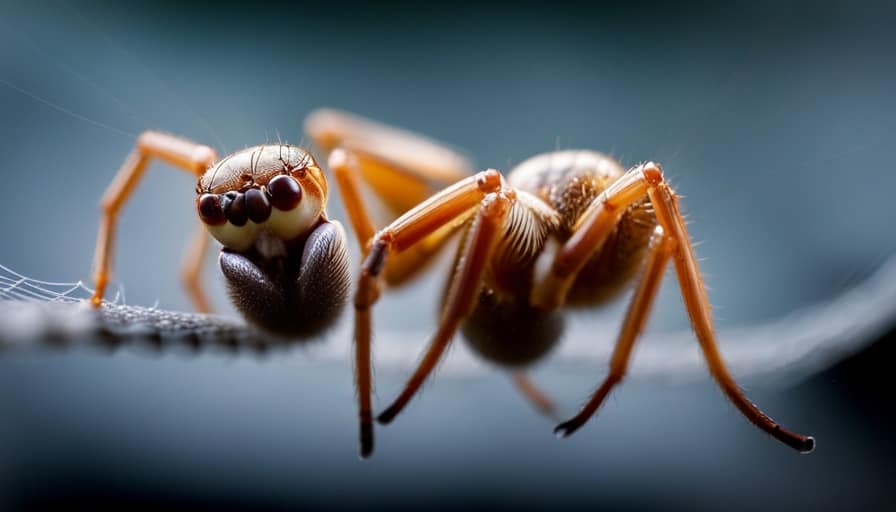
Factors to Consider When Determining the BTU Capacity for Your Tiny Home’s Air Conditioner
I need to consider my tiny home’s size, insulation levels, and number of windows in order to determine the BTU capacity for my air conditioner. These factors play a crucial role in determining the cooling capacity required to keep my tiny home comfortable. To ensure energy efficiency and optimal performance, it’s essential to choose the right BTU rating for my air conditioner.
Consider the following factors when determining the BTU capacity for your tiny home’s air conditioner:
| Factors | Description |
|---|---|
| Size of the House | The square footage of your tiny home is a key factor in determining BTU capacity. A larger space will require a higher cooling capacity. |
| Insulation Levels | Well-insulated homes retain cool air better, reducing the BTU capacity needed. |
| Number of Windows | Windows contribute to heat gain. More windows may require a higher BTU capacity. |
Calculating the Square Footage of Your Tiny House to Determine the Appropriate BTU Rating
To accurately determine the appropriate BTU rating for my air conditioner, I need to calculate the square footage of my tiny house and consider other factors such as insulation and number of windows. Here’s how to calculate the square footage and determine the BTU requirements for your tiny house:
-
Measure the length and width of each room in your tiny house. Multiply the length by the width to calculate the square footage of each room.
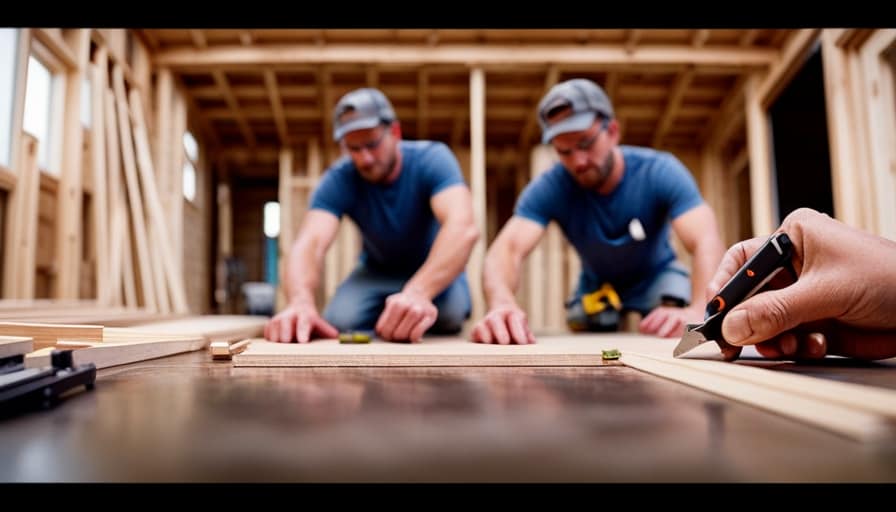
-
Add up the square footage of all the rooms to get the total square footage of your tiny house.
-
Consider the insulation in your walls, roof, and floor. Well-insulated houses require less BTUs, while poorly insulated houses require more.
-
Take into account the number and size of windows in your tiny house. Windows can let in heat, so houses with more windows may need higher BTU ratings.
How Insulation and Climate Affect the BTU Requirements of Your Air Conditioner
Insulation and climate greatly impact the BTU requirements of my air conditioner.
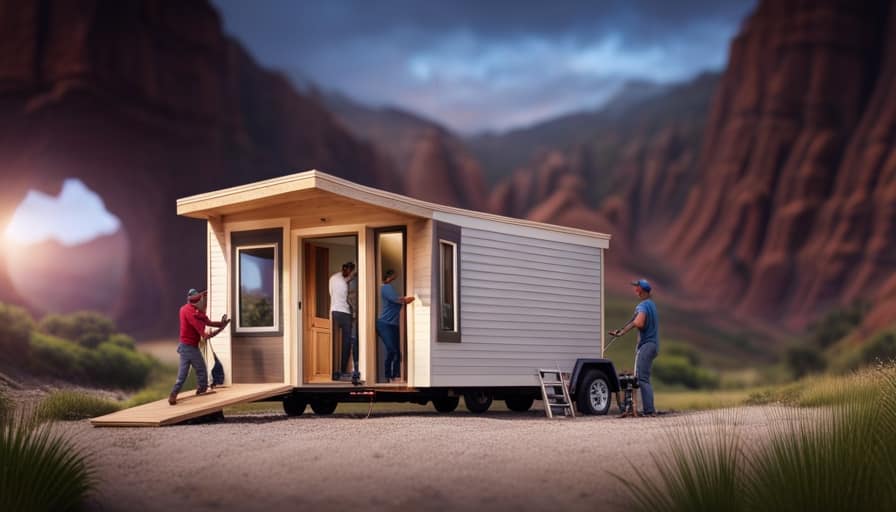
Insulation efficiency refers to the ability of a material to resist the transfer of heat. Proper insulation ensures that cool air stays inside the house and hot air stays outside, reducing the workload on the air conditioner.
Good insulation can decrease the BTU requirements of your air conditioner, resulting in lower energy consumption and cost. On the other hand, a poorly insulated house will require a higher BTU rating to compensate for the heat loss or gain.
Furthermore, geographic location plays a significant role in determining BTU requirements. Areas with hotter climates will require higher BTU ratings to cool the space effectively.
Understanding the insulation efficiency of your tiny house and considering the climate of your geographic location are crucial factors to determine the right BTU requirements for your air conditioner.
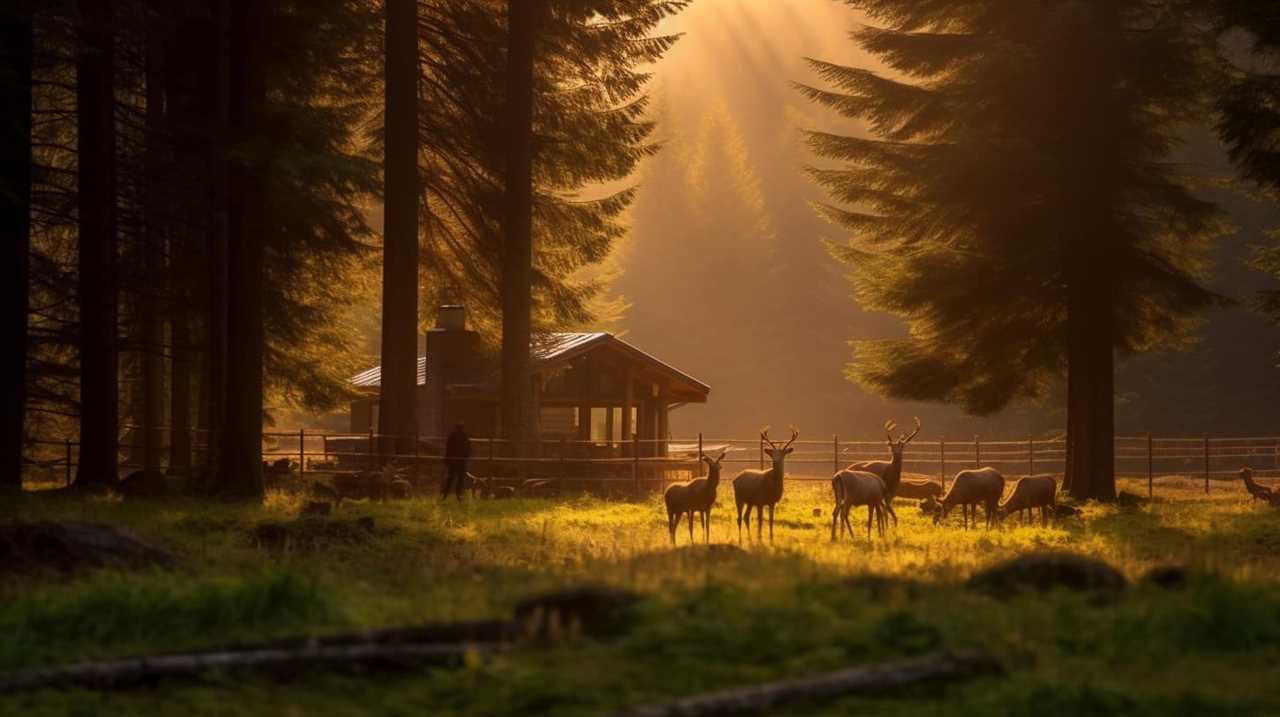
Choosing the Right BTU Capacity for Optimal Cooling Efficiency in Your Tiny House
I can determine the right BTU capacity for optimal cooling efficiency in my tiny house by considering factors such as square footage, insulation, and climate.
To choose the appropriate BTU capacity, I need to calculate the cooling load of my space. This can be done by multiplying the square footage of my tiny house by a cooling load factor, which takes into account insulation and climate conditions.
Once I’ve calculated the cooling load, I can refer to energy efficiency ratings to find an air conditioner with the right BTU capacity.
Here are four important factors to consider:
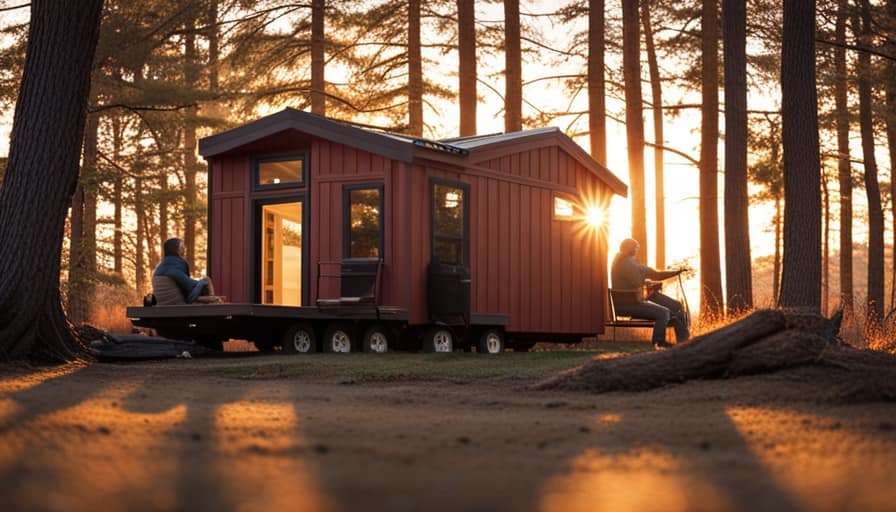
- Square footage of the tiny house.
- Insulation quality and R-value.
- Climate conditions, such as average temperatures and humidity levels.
- The desired temperature and cooling preferences.
Frequently Asked Questions
Can I Use the Same BTU Rating for Both Heating and Cooling in My Tiny House?
Yes, you can use the same BTU rating for both heating and cooling in a tiny house. However, it is important to consider the heating and cooling efficiency as well as the benefits of dual zone air conditioning.
What Is the Average Lifespan of an Air Conditioner in a Tiny House?
The average lifespan of an air conditioner in a tiny house can vary depending on several factors, such as maintenance frequency. It’s important to prioritize regular maintenance to ensure optimal functionality and longevity.
Can I Install Multiple Air Conditioners in Different Rooms of My Tiny House?
I can install multiple portable ACs in different rooms of my tiny house. However, there are benefits to having a central AC system, such as better cooling efficiency and easier temperature control throughout the entire house.
How Often Should I Clean or Maintain My Air Conditioner in a Tiny House?
I should clean or maintain my air conditioner in a tiny house regularly. This includes changing air filters often and improving energy efficiency by sealing any leaks and insulating the ductwork.

Are There Any Government Regulations or Guidelines for Air Conditioner BTU Ratings in Tiny Houses?
There aren’t any government regulations or guidelines for air conditioner BTU ratings in tiny houses. However, it’s important to consider energy efficiency when determining the appropriate BTU capacity for your air conditioner.
Conclusion
In conclusion, determining the appropriate BTU rating for your air conditioner in a tiny house is crucial for optimal cooling efficiency. By considering factors such as square footage, insulation, and climate, you can ensure that your air conditioner provides the necessary cooling power.
Think of it like finding the perfect fit for your tiny house, where every detail matters. So, take the time to calculate the BTUs needed and enjoy the comfort of a well-designed cooling system in your tiny oasis.
I’m Theodore, and I love tiny houses. In fact, I’m the author of Tiny House 43, a book about tiny houses that are also tree houses. I think they’re magical places where imaginations can run wild and adventures are just waiting to happen.
While tree houses are often associated with childhood, they can be the perfect adult retreat. They offer a cozy space to relax and unwind, surrounded by nature. And since they’re typically built on stilts or raised platforms, they offer stunning views that traditional homes simply can’t match.
If you’re looking for a unique and romantic getaway, a tree house tiny house might just be the perfect option.
Beginners Guides
How Do I Make a Tiny House Ladder

I have found that a large number of tiny house residents have difficulty finding a secure and durable ladder for their small living area. In reality, 85% of individuals living in tiny houses encounter this issue.
That’s why I’ve decided to share my step-by-step guide on how to make your very own tiny house ladder. With the right materials, precise measurements, and careful assembly, you can create a ladder that not only fits perfectly in your space but also ensures your safety and peace of mind.
Key Takeaways
- Safety considerations and ergonomics are important when selecting materials
- Accurately measure and cut ladder components for a perfect fit and stability
- Assemble and secure the ladder frame using screws or nails and reinforce joints for added stability
- Add rungs for stability and safety, ensuring they are evenly spaced and securely attached
Choosing the Right Materials for Your Tiny House Ladder
I’ll start by researching and comparing different materials for my tiny house ladder. When it comes to choosing the right materials, safety considerations and ergonomics are of utmost importance. Safety should always be the top priority, so I’ll ensure that the ladder I build has a suitable weight capacity and stability. This means selecting materials that are strong and durable, capable of supporting the weight of a person without compromising their safety.
Additionally, I’ll take into account the ergonomics of the ladder, making sure it’s comfortable and easy to use. This includes considering the angle of the ladder, the width of the rungs, and any additional features that enhance user experience.
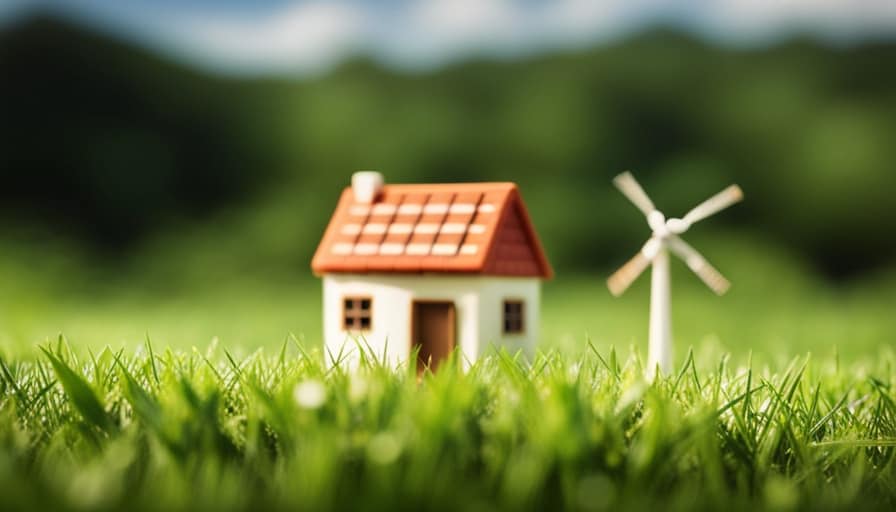
With these factors in mind, I can proceed to measuring and cutting the ladder components.
Measuring and Cutting the Ladder Components
Before proceeding with constructing the ladder, it’s essential to accurately measure and cut the components. Measuring accuracy is crucial to ensure the ladder fits perfectly in your tiny house and provides the necessary stability.
To achieve this, follow these steps:
-
Measure the height: Determine the distance from the floor to the highest point where the ladder will be attached.
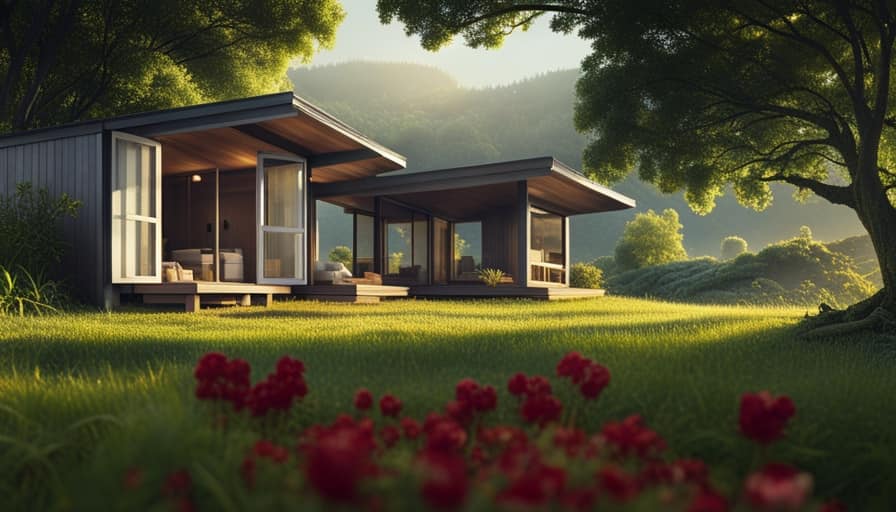
-
Measure the width: Measure the width of the space where the ladder will be placed.
-
Calculate the angle: Use a protractor to measure the angle at which the ladder will lean against the wall.
Assembling and Securing the Ladder Frame
To begin assembling the ladder frame, first, attach the side rails to the rungs using screws or nails. Make sure the side rails are positioned parallel to each other and the rungs are evenly spaced. Use a measuring tape to ensure accuracy.
Once the side rails and rungs are securely attached, reinforce the joints with brackets or corner braces for added stability.
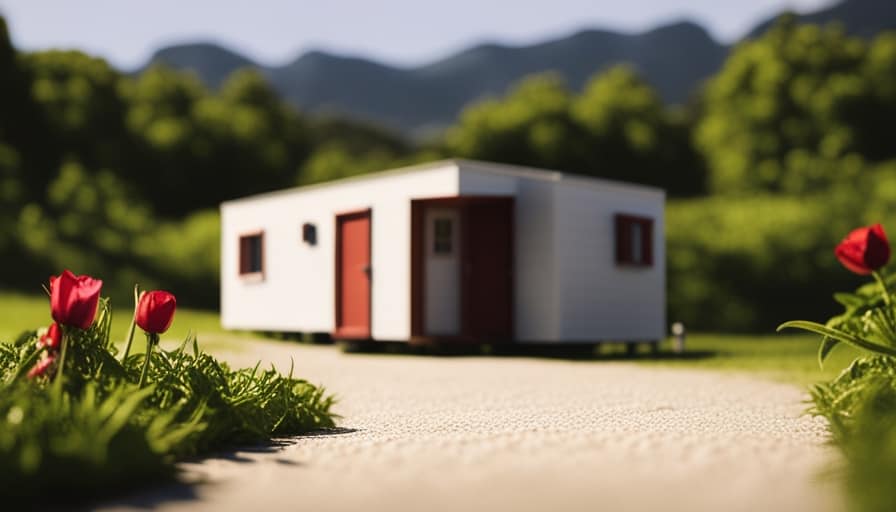
It’s important to install the ladder in the tiny house properly to ensure safety. Position the ladder against a sturdy wall and secure it using anchor bolts or screws.
Regular maintenance is crucial for long-lasting use of the ladder. Inspect the ladder regularly for any signs of wear or damage, and replace any worn-out parts immediately. Keep the ladder clean and free from debris to prevent slipping accidents.
Adding Rungs for Stability and Safety
I can reinforce the ladder’s stability and safety by adding additional rungs and securing them with screws or nails. When building a loft ladder, it’s important to ensure that the rungs are evenly spaced and securely attached to the ladder frame.
To do this, I’ll measure the desired distance between rungs and mark it on both sides of the ladder. Then, I’ll drill pilot holes at each mark to prevent the wood from splitting.
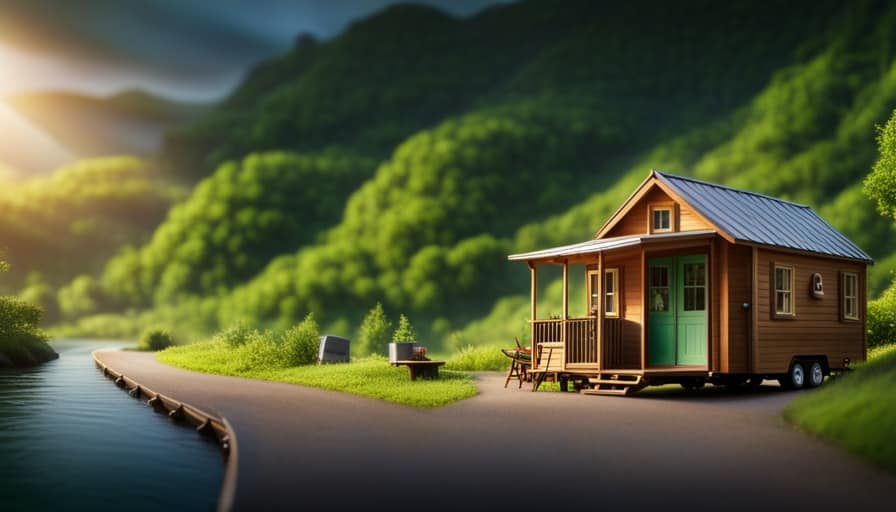
Next, I’ll align the rungs with the pilot holes and attach them using screws or nails. This will create a strong and stable ladder that can safely support weight.
Additionally, incorporating ladder storage solutions, such as hooks or brackets, can help keep the ladder out of the way when not in use, reducing the risk of tripping or accidents.
Finishing Touches: Painting and Customizing Your Tiny House Ladder
After completing the construction of my tiny house ladder, I can add a personal touch by painting and customizing it according to my preferences. Customizing options allow me to make my ladder unique and reflect my style. Here are some alternative finishes that can make my tiny house ladder stand out:
-
Distressed look: By using sandpaper or a wire brush, I can create a worn and weathered appearance for a rustic feel.

-
Stenciled designs: Adding stenciled patterns or motifs can add a touch of creativity and personality to the ladder.
-
Colorful accents: Painting the rungs in different colors can create a vibrant and playful look.
-
Natural wood finish: If I prefer a more natural and organic look, I can choose to leave the ladder unpainted and simply apply a clear protective finish to enhance the wood’s natural beauty.
Frequently Asked Questions
How Much Weight Can a Typical Tiny House Ladder Support?
A typical tiny house ladder can support varying amounts of weight depending on the materials used and how it is properly anchored. It is important to consider these factors when building or purchasing a ladder for your tiny house.
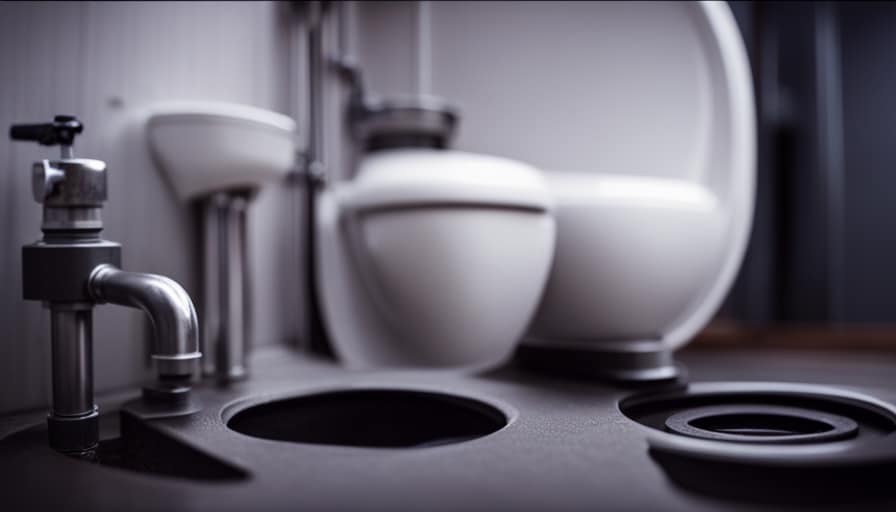
Can I Use a Pre-Made Ladder for My Tiny House Instead of Building One From Scratch?
Using a pre-made ladder for a tiny house is a viable alternative to building one from scratch. However, consider the pros and cons. Building allows customization, while buying offers convenience. Evaluate your needs and skills before deciding.
Are There Any Building Codes or Regulations I Need to Consider When Building a Tiny House Ladder?
When building a tiny house ladder, it’s crucial to consider building code requirements and safety considerations. Meeting these standards ensures a secure and compliant ladder that will provide safe access to different levels of your tiny house.
Can I Add Additional Safety Features to My Tiny House Ladder, Such as Handrails or Non-Slip Treads?
Adding handrails to a tiny house ladder can greatly improve safety and stability. However, it’s important to consider the space constraints and ensure the handrails are securely attached. Non-slip treads can also enhance traction and prevent accidents.
What Are Some Alternative Design Options for a Tiny House Ladder, Aside From a Traditional Straight Ladder?
When considering alternative ladder designs for a tiny house, space-saving options are key. Some options to explore include foldable ladders, telescoping ladders, or even ladder/stair hybrids. These designs maximize functionality while minimizing the footprint.
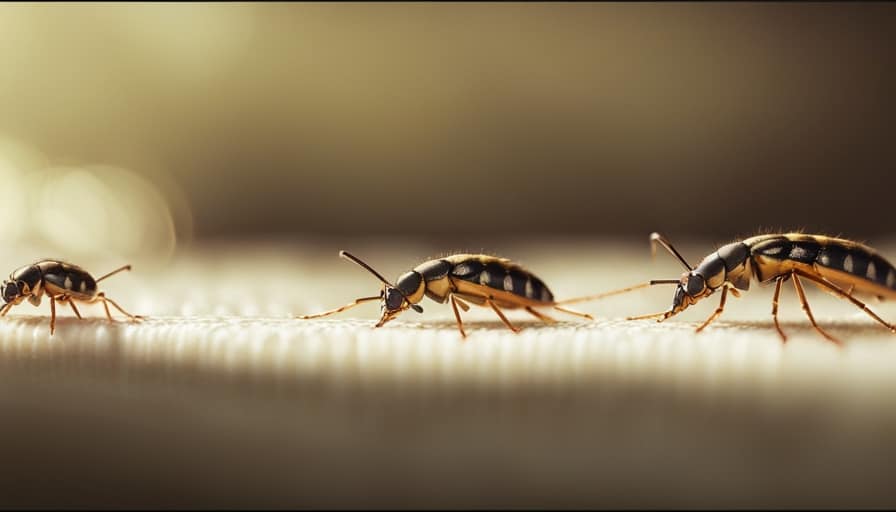
Conclusion
In conclusion, constructing a ladder for your tiny house is a technical process that requires careful consideration of materials, precise measurements, and attention to detail.
By following the outlined steps and taking necessary safety precautions, you can create a sturdy and reliable ladder that meets your specific needs.
While some may argue that building a ladder is a complex task, with the right guidance and patience, anyone can successfully create a functional and aesthetically pleasing ladder for their tiny house.
I’m Theodore, and I love tiny houses. In fact, I’m the author of Tiny House 43, a book about tiny houses that are also tree houses. I think they’re magical places where imaginations can run wild and adventures are just waiting to happen.
While tree houses are often associated with childhood, they can be the perfect adult retreat. They offer a cozy space to relax and unwind, surrounded by nature. And since they’re typically built on stilts or raised platforms, they offer stunning views that traditional homes simply can’t match.
If you’re looking for a unique and romantic getaway, a tree house tiny house might just be the perfect option.
Beginners Guides
How Do I Hook up a Tiny House

I have always fantasized about living in a small house, but connecting it to utilities seemed overwhelming. That’s why I chose to explore the realm of small house hookups and share my discoveries with you.
In this article, we’ll explore everything from choosing the right location to connecting to water, electricity, and sewage systems. So, if you’re ready to turn your tiny house dreams into reality, let’s get started on this step-by-step journey together.
Key Takeaways
- Choose a clean and safe water source and use a water pressure regulator and filtration system.
- Consider grid connection for reliable electricity and install solar panels and batteries for free electricity.
- Install a septic tank or connect to a municipal sewer system and use composting toilets and greywater systems for an eco-friendly approach to waste management.
- Ensure proper ventilation for good air quality, implement fire safety measures, and comply with safety regulations and building codes.
Choosing the Right Location for Your Tiny House
I’ve always dreamed of finding the perfect spot to set up my tiny house. When choosing the right location, there are two important factors to consider: zoning regulations and environmental impact.
First, it’s crucial to understand the zoning regulations in the area where you plan to place your tiny house. Different jurisdictions may have specific requirements and restrictions regarding the size, placement, and usage of tiny houses. Researching and complying with these legal requirements will ensure a smooth and hassle-free experience.

Additionally, it’s essential to consider the environmental impact of your chosen location. Look for a spot that minimizes disruption to the natural surroundings and promotes sustainability. Consider factors such as access to public transportation, proximity to amenities, and the potential for renewable energy sources.
Water Hookup: Connecting Your Tiny House to a Water Source
To connect my tiny house to a water source, I’ll need to use a hose and a water pressure regulator.
First, I’ll locate the water source and ensure it’s clean and safe.
Next, I’ll attach the water pressure regulator to the hose to control the water flow. This is important to prevent any damage to the plumbing system in my tiny house.

Before connecting the hose to the water source, it’s recommended to use a water filtration or purification system to ensure clean and safe water for everyday use.
Once the hose is connected, I’ll turn on the water source and check for any leaks.
It’s important to regularly maintain and clean the water filtration or purification system to ensure optimal performance and safe drinking water in my tiny house.
Powering Your Tiny House: Electricity Hookup Options
There are several electricity hookup options available for powering my tiny house. The most common ones are grid connection, solar power, and generator.
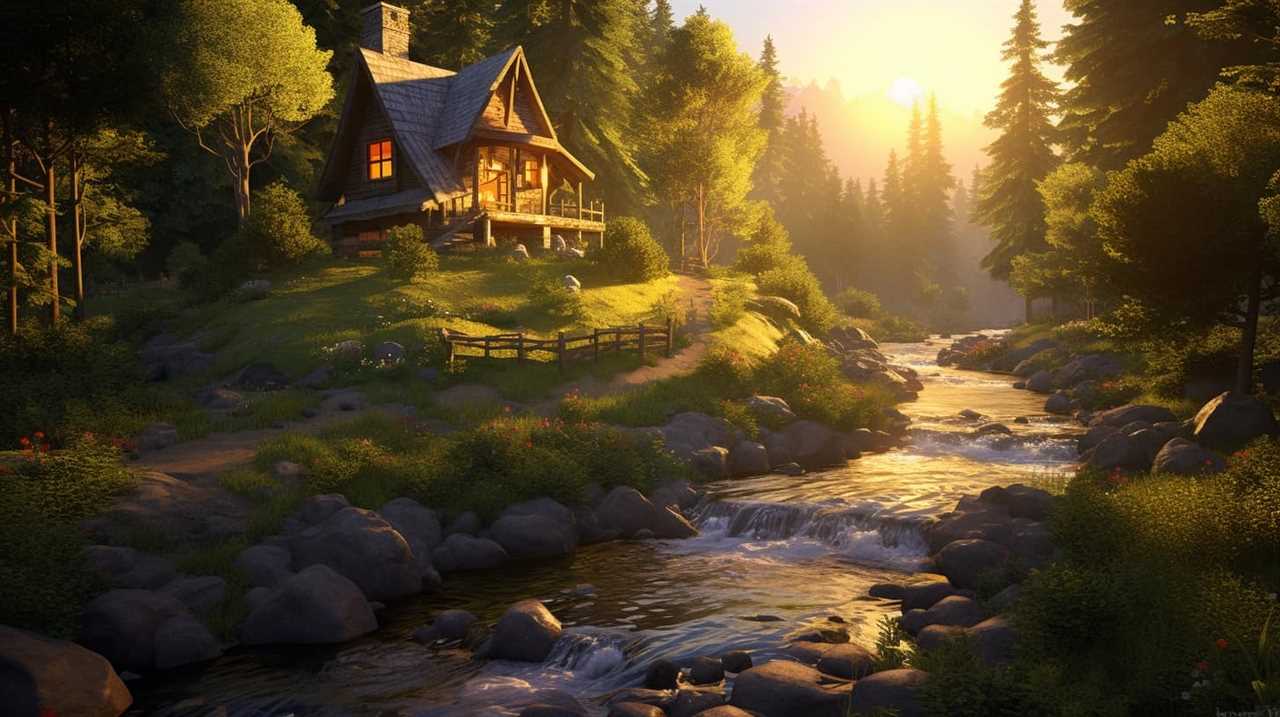
Grid connection involves connecting my tiny house to the local power grid. This option provides a reliable source of electricity. It requires installing a meter and paying monthly utility bills.
On the other hand, solar power is a more sustainable and environmentally friendly option. By installing solar panels on the roof of my tiny house, I can harness the power of the sun to generate electricity. Though it requires an initial investment in the solar panels and batteries, it can provide me with free electricity in the long run.
Lastly, generator options are available for those who prefer a backup power source. A generator can be used to power my tiny house when there’s no access to grid electricity or when the solar panels aren’t generating enough power. It’s important to choose a generator that’s suitable for the power needs of my tiny house and to have a reliable fuel source.
Transitioning into the next section on waste management, it’s important to consider how to hook up my tiny house to sewage systems.
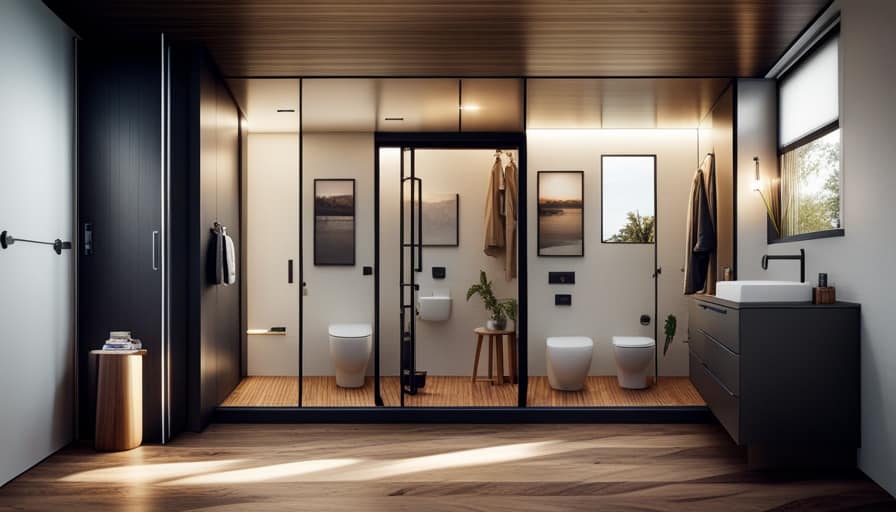
Waste Management: Hooking up Your Tiny House to Sewage Systems
I can connect my tiny house to sewage systems using either a septic tank or a sewer hookup. When it comes to waste management in a tiny house, there are a few options to consider. Here are three ways to hook up your tiny house to sewage systems:
-
Septic tank: Installing a septic tank requires digging a hole in the ground and placing a large tank where waste can be collected and treated. This is a more permanent solution that requires regular maintenance and pumping.
-
Sewer hookup: If your tiny house is located in an area with access to a municipal sewer system, you can connect directly to it. This option eliminates the need for a septic tank and allows for easy disposal of waste.
-
Composting toilets and greywater systems: If you prefer a more eco-friendly approach, you can install a composting toilet and a greywater system. Composting toilets use natural processes to break down waste, turning it into compost. Greywater systems collect and filter wastewater from sinks and showers, allowing it to be reused for irrigation.
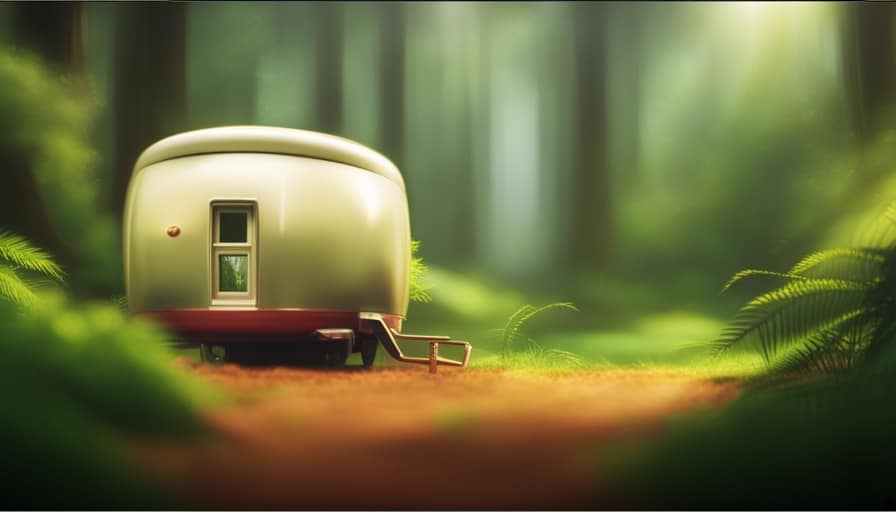
By utilizing these waste management options, you can ensure a clean and efficient sewage system for your tiny house.
Transitioning into the next section, it’s important to also consider safety and compliance in all aspects of your tiny house hookups.
Ensuring Safety and Compliance in Tiny House Hookups
One must ensure that their tiny house hookups are safe and compliant with regulations. Ensuring proper ventilation and fire safety measures are crucial steps in making sure that your tiny house is a safe and comfortable place to live. Here are some steps to follow:
-
Ventilation: Proper ventilation is important to maintain good air quality and prevent the buildup of moisture and odors. Install exhaust fans or vents in the kitchen, bathroom, and any other areas where moisture or fumes may accumulate.
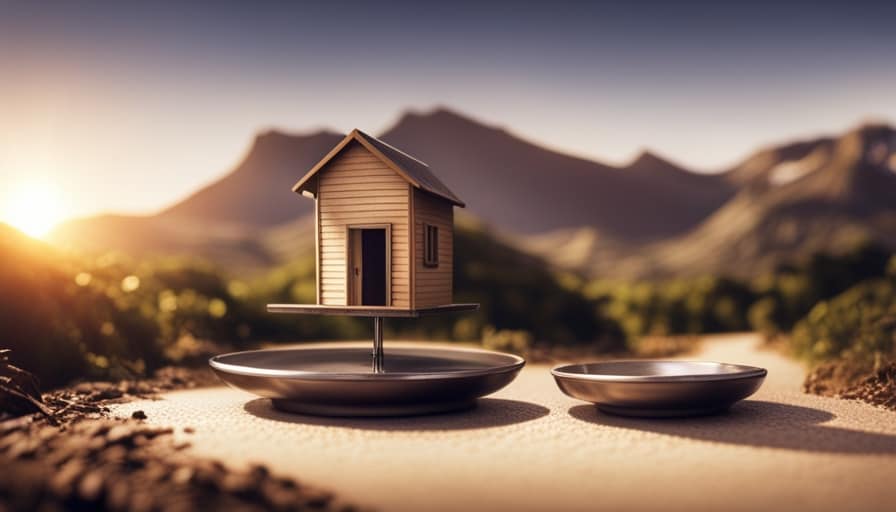
-
Fire Safety Measures: Fire safety is paramount in any living space. Install smoke detectors and carbon monoxide detectors in your tiny house. Place fire extinguishers in accessible locations and ensure that they are regularly inspected and maintained.
-
Compliance with Regulations: Familiarize yourself with local building codes and regulations to ensure that your tiny house meets all safety requirements. This includes electrical, plumbing, and structural components.
By taking these precautions, you can enjoy your tiny house while also ensuring the safety and compliance of your hookups.
| Safety Measures | Steps to Follow |
|---|---|
| Ventilation | Install exhaust fans or vents in kitchen, bathroom, and other areas where moisture or fumes accumulate. |
| Fire Safety Measures | Install smoke detectors, carbon monoxide detectors, and fire extinguishers. Familiarize yourself with local building codes and regulations. |
| Compliance with Regulations | Ensure that your tiny house meets all safety requirements, including electrical, plumbing, and structural components. |
Frequently Asked Questions
How Much Does It Cost to Hook up a Tiny House to a Water Source?
When hooking up a tiny house to a water source, the cost can vary depending on factors like location and type of connection. It’s important to compare costs and consider alternative options to find the best solution for your budget.
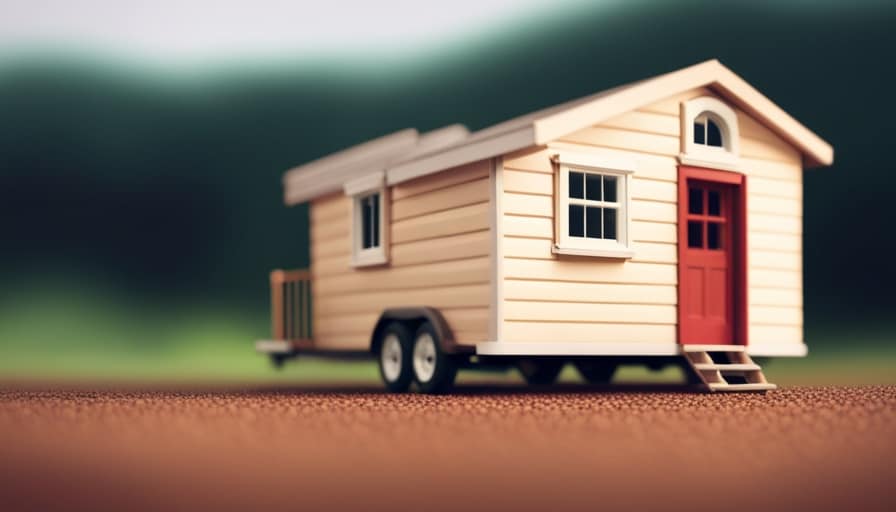
Can I Hook up My Tiny House to a Well Instead of a Municipal Water Source?
Well water versus municipal water for a tiny house has its pros and cons. While a well can provide independence and cost savings, it requires maintenance and may have limited supply. Municipal water offers convenience but comes with monthly bills.
Are There Any Specific Electrical Codes or Regulations I Need to Be Aware of When Hooking up My Tiny House?
When hooking up a tiny house, it’s crucial to be aware of electrical code requirements and safety precautions. These regulations ensure that your electrical system is safe and up to standard. Always consult with a licensed electrician to ensure compliance.
How Often Do I Need to Empty My Tiny House’s Sewage System?
To maintain my tiny house sewage system, I make sure to clean it regularly. The frequency depends on usage, but generally, it needs to be emptied every 1-3 weeks. Proper maintenance ensures a clean and odor-free living environment.
Can I Install Solar Panels to Power My Tiny House Instead of Connecting to the Grid?
I can install solar panels to power my tiny house instead of connecting to the grid. It offers benefits like energy independence, lower utility bills, and environmental friendliness. However, it may require a larger upfront investment and limited power supply on cloudy days.

Conclusion
In conclusion, hooking up a tiny house requires careful consideration of several factors. These include the location of the house, the available options for water hookup, the available options for electricity hookup, and waste management. By following the step-by-step instructions provided in this article, you can ensure a safe and compliant setup for your tiny house.
So, are you ready to embark on your tiny house adventure and create a cozy and sustainable living space?
I’m Theodore, and I love tiny houses. In fact, I’m the author of Tiny House 43, a book about tiny houses that are also tree houses. I think they’re magical places where imaginations can run wild and adventures are just waiting to happen.
While tree houses are often associated with childhood, they can be the perfect adult retreat. They offer a cozy space to relax and unwind, surrounded by nature. And since they’re typically built on stilts or raised platforms, they offer stunning views that traditional homes simply can’t match.
If you’re looking for a unique and romantic getaway, a tree house tiny house might just be the perfect option.
-

 Beginners Guides2 weeks ago
Beginners Guides2 weeks agoHow To Buy A Tesla Tiny House
-

 Energy Efficiency1 month ago
Energy Efficiency1 month agoBest Tiny Homes For Cold Climates
-

 Beginners Guides7 days ago
Beginners Guides7 days agoTiny House Nation Where Are They Now Stephanie
-

 Tiny House Resources (e.g., legalities, cost, insurance, FAQs)2 months ago
Tiny House Resources (e.g., legalities, cost, insurance, FAQs)2 months agoDo Tiny Homes Need Planning Permission?
-

 Beginners Guides2 weeks ago
Beginners Guides2 weeks agoFrom The Show Tiny House Nation How Many Keep Their Tiny House?
-

 Beginners Guides2 months ago
Beginners Guides2 months agoUsing a Climbing Net For Treehouse Construction
-

 Beginners Guides2 months ago
Beginners Guides2 months agoHow to Build a Treehouse Without Drilling Into the Tree
-

 Beginners Guides3 weeks ago
Beginners Guides3 weeks agoTiny House Nation Who Pays For The Houses




